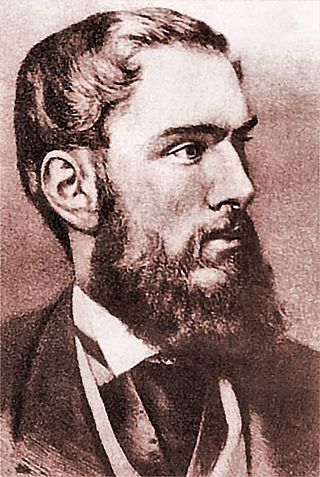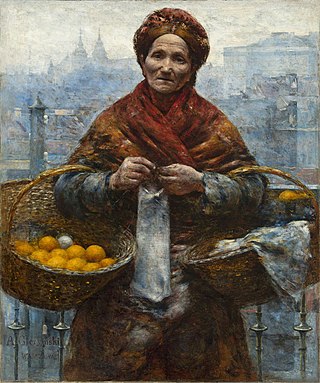
Stanisław Witkiewicz was a Polish painter, art theoretician, and amateur architect, known for his creation of "Zakopane Style".

Józef Marian Chełmoński was a Polish painter of the realist school with roots in the historical and social context of the late Romantic period in partitioned Poland. He is famous for monumental paintings now at the Sukiennice National Art Gallery in Kraków and at the MNW in Warsaw.

Wilanów Palace is a former royal palace located in the Wilanów district of Warsaw, Poland. It was built between 1677–1696 for King of Poland John III Sobieski according to a design by architect Augustyn Wincenty Locci. Wilanów Palace survived Poland's partitions and both World Wars, and so serves as one of the most remarkable examples of Baroque architecture in the country.

Stefan Gierowski was a Polish painter and an avant garde artist of post-war Poland.

Maksymilian Dionizy Gierymski was a Polish painter, specializing mainly in watercolours. He was the older brother of painter Aleksander Gierymski.

Władysław Podkowiński was a Polish master painter and illustrator associated with the Young Poland movement during the Partition period.

Stanisław Masłowski was a Polish painter of realistic style, the author of watercolor landscapes.

Ignacy Aleksander Gierymski was a Polish painter of the late 19th century, the younger brother of Maksymilian Gierymski. He was a representative of Realism as well as an important precursor of Impressionism in Poland.

Andrzej Krystyn Wróblewski was a Polish figurative painter who died in a mountaineering accident in 1957 when he was only 29. He is recognized by many as one of Poland's most prominent artists in the early post World War II era, creating a distinctly individualistic approach to representational art.

The Gallery of 19th-Century Polish Art at Sukiennice, is a division of the National Museum, Kraków, Poland. The Gallery is housed on the upper floor of the Renaissance Sukiennice Cloth Hall in the center of the Main Market Square in Old Town Kraków.

Anna Bilińska was a Polish painter, known for her portraits. A representative of realism, she spent most of her life in Paris, and is considered the "first internationally known Polish woman artist."

Aleksander Lesser was a Polish painter, illustrator, sketch artist, art critic, and amateur researcher of antiquities. Lesser was Jewish, and became one of the first artists to depict scenes from modern Jewish history in Poland. He specialized in Polish historical and contemporary themes, and he was known and respected in artistic and scholarly circles. He was a member of Kraków's Academy of Learning and co-founder of Warsaw's Zachęta, the Society for Encouragement of the Fine Arts.

Maciej Masłowski was a Polish art historian.

Stanisław Kuczborski was a Polish modernist painter, graphic artist and caricaturists. His mother, Klotylda Kuczborska was a sister of renowned painters Aleksander Gierymski and Maksymilian Gierymski. Kuczborski studied painting in Kraków at the School of Fine Arts under Leon Wyczółkowski and Jan Stanisławski before continuing his art education in Paris. He was a co-founder and participant of the legendary Zielony Balonik art-and-literary cabaret in Kraków. His lithographs published in Liberum Veto and Hrabia Wojtek, appeared in Teka Melpomeny collection (1904) about personalities in the local theatre. One of his better-known paintings inspired by the Young Poland movement is the Funeral (1904), depicting village folk from Bronowice. Kuczborski married Zofia Munk with whom he had a daughter, Irena Kuczborska (1907–1971), also a fine arts painter.

Maurycy Trębacz was one of the most popular Jewish painters in Poland in the late 19th and early 20th century. Many of his paintings were lost in the Holocaust, but a representative selection of his artwork survived. Trębacz died of starvation in the Litzmannstadt Ghetto during the Nazi German occupation of Poland.

Jewess with Oranges is an oil painting on canvas by Aleksander Gierymski finished in 1881 and purchased by the National Museum, Warsaw in 1928.

The Battle of Orsha is a painting of the Battle of Orsha, which was fought on September 8, 1514 between the allied forces of the Grand Duchy of Lithuania and the Kingdom of Poland against the Vasili III's army of the Grand Duchy of Moscow (left) as part of the Muscovite–Lithuanian Wars.

Peasant Coffin is an oil painting by Polish artist Aleksander Gierymski, created in 1895.

Indian Summer is an 1875 oil painting by Polish Realist painter Józef Chełmoński. It is considered one of the artist's most acclaimed works and is currently displayed at the National Museum in Warsaw, Poland.

The Prisoners is an 1883 oil painting by Polish painter Jacek Malczewski. It depicts a group of Polish political prisoners exiled to Siberia for their participation in the national January Uprising of 1863–1864 against Tsarist Russia. It is now displayed at the National Museum in Warsaw.




















